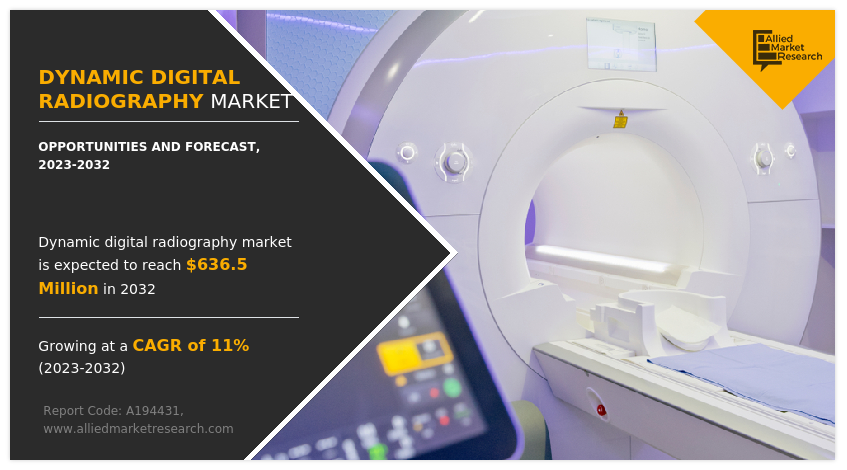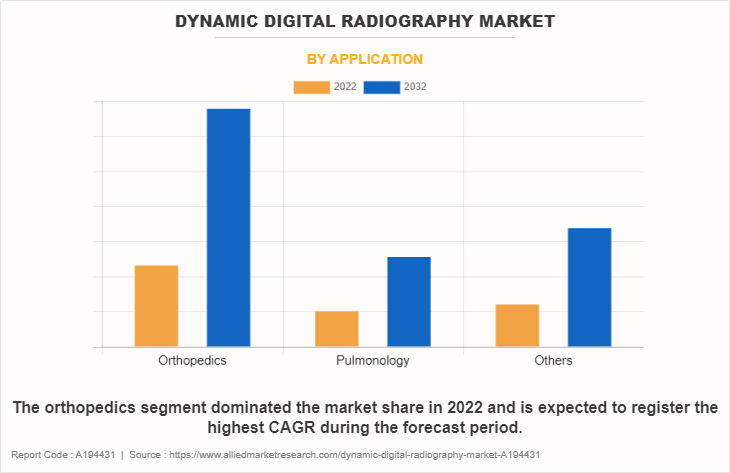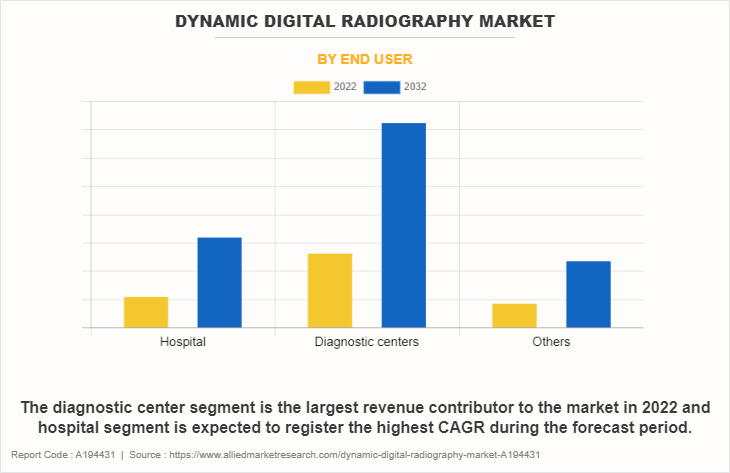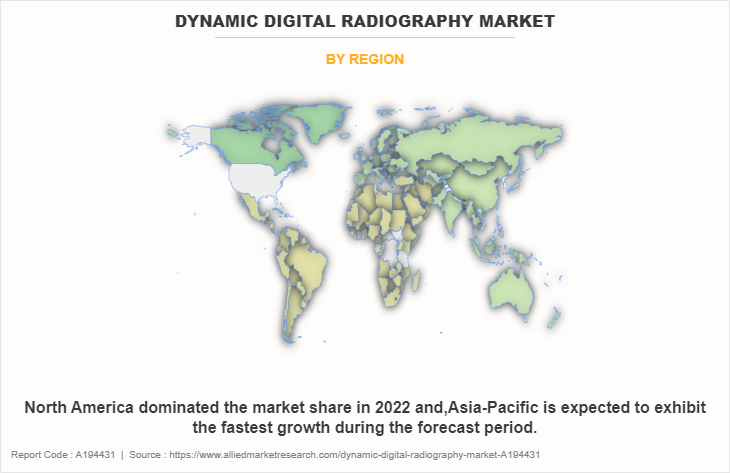Dynamic Digital Radiography Market Research, 2032
The global dynamic digital radiography market size was valued at $225.5 million in 2022, and is projected to reach $636.5 million by 2032, growing at a CAGR of 11% from 2023 to 2032. Dynamic Digital Radiography (DDR) is an advanced medical imaging technique that offers a unique and enhanced perspective on the human body's internal structures. Unlike traditional static X-ray imaging, which provides a single snapshot of the body, DDR captures real-time, high-resolution moving images. This technology utilizes a digital X-ray detector and sophisticated image processing algorithms to create detailed videos of anatomical structures in motion.

Market Dynamics
The dynamic digital radiography market size in expected to grow significantly, owing to surge in adoption of dynamic digital radiography technique to evaluate and examine functions of internal organs, bones and joints of the patients, low emission of harmful radiation by dynamic digital radiography equipment and real time imaging by dynamic digital radiography.
The adoption of dynamic digital radiography techniques has emerged as a pivotal advancement in the realm of medical imaging, particularly for the evaluation and examination of the functional aspects of internal organs, bones, and joints in patients. This progressive technology has rapidly positioned itself as a major driver propelling the growth of the dynamic digital radiography industry.
Unlike traditional static radiography, dynamic digital radiography allows for the real-time visualization of anatomical structures and physiological processes, thereby offering a more comprehensive and nuanced understanding of the body's internal dynamics. According to Konica Minolta, a leading manufacturer of medical imaging equipment, dynamic digital radiography supports diagnosing musculoskeletal conditions by presenting diagnostic detail in full motion.
Dynamic digital radiography technique enabling healthcare professionals to track the real-time functionality of organs, bones, and joints. This real-time insight proves invaluable in diagnosing and monitoring conditions such as musculoskeletal disorders, respiratory ailments, and gastrointestinal issues. According to a 2021 study by National Library of Medicine, it was reported that sequential chest X-ray images provided by dynamic digital radiography during respiration make it easy for both operators and patients to understand the respiratory kinetics of the chest.
In addition, dynamic digital radiography approach holds significant promise in diagnosing a myriad of musculoskeletal conditions and disorders. By offering insights into joint stability, range of motion, and overall biomechanics, dynamic digital radiography provides orthopedic specialists with valuable information that was previously challenging to attain through conventional imaging methods.
According to a 2023 study by Journal of Shoulder and Elbow Surgery, dynamic digital radiography can be used to assist with the diagnosis of shoulder instability, particularly in the posterior direction. Thus, the high adoption of dynamic digital radiography technique to evaluate and examine functional accepts of internal organs, bones and joints of the patients is expected to drive the growth of the dynamic digital radiography industry.
The dynamic digital radiography market forecast shows a remarkable surge in growth, with a major driving factor being the heightened focus on minimizing harmful radiation emissions.. Traditional radiography techniques often involve the use of ionizing radiation to generate images of the internal structures of the human body, aiding in the diagnosis and monitoring of various medical conditions.
According to a factsheet by the International Atomic Energy Agency, even low levels of radiation exposure can cause cancer or genetic effects. Dynamic digital radiography offers a groundbreaking solution by significantly reducing the emission of harmful radiation during the imaging process. Thus, the dynamic digital radiography market is expected to be propelled by the compelling need for low emission of harmful radiation.
Furthermore, the integration of Artificial Intelligence (AI) has emerged as a transformative force, significantly driving advancements in the field of dynamic digital radiography (DDR) and subsequently fueling the growth of the dynamic digital radiography market. AI integration within dynamic digital radiography has revolutionized the way medical professionals interpret and diagnose patients' conditions.
By leveraging machine learning algorithms, AI enhances the analysis of DDR scans, enabling the extraction of intricate insights from complex imaging data. This, in turn, facilitates more accurate and timely diagnoses of various medical conditions, including musculoskeletal disorders, respiratory issues, and cardiovascular abnormalities.
In October 2022, Emory University researcher received a Second Place Award and the Presenter’s Choice Award at the 2022 Orthopedic Research and Education Foundation (OREF) for their study on artificial intelligence automated analysis of scapula dynamics using dynamic digital radiography. The research demonstrated that the AI tool has good reliability (ICC 0.58 (95% confidence interval 0.4-0.71)) between manual and AI measurements of scapulohumeral rhythm (SHR). The AI-powered dynamic digital radiography systems excel in detecting subtle anomalies that might be challenging to identify with traditional imaging techniques, consequently reducing the chances of misdiagnosis and allowing for prompt intervention.
However, high costs dynamic digital radiography equipment is expected to act as a significant restraint for the dynamic digital radiography market growth. Moreover, a rise in awareness about the ALARA (As Low as Reasonably Achievable) principle is expected to present significant growth opportunities. The ALARA principle revolves around minimizing radiation exposure to patients and healthcare professionals while still obtaining diagnostically valuable images. This principle has gained substantial recognition in recent years as the medical community emphasizes the importance of patient safety and the reduction of unnecessary radiation doses.
The dynamic digital radiography market opportunity is closely aligned with the ALARA principle, emphasizing the importance of minimizing radiation exposure during medical imaging. This technology allows healthcare providers to capture high-quality images with lower radiation doses compared to traditional radiography methods. As medical institutions and professionals increasingly prioritize patient safety and strive to adhere to radiation safety guidelines, the demand for dynamic digital radiography solutions has grown significantly.
The awareness of the ALARA principle has also been fueled by advancements in digital imaging technology, making it easier for healthcare providers to implement low-dose imaging protocols without compromising diagnostic accuracy. Furthermore, regulatory bodies and industry associations have been actively promoting the ALARA principle, encouraging the adoption of technologies that align with its objectives. This has led to a more favorable environment for the growth of the dynamic digital radiography market share, as healthcare facilities seek solutions that allow them to maintain or improve diagnostic capabilities while minimizing radiation exposure.
The 2023 recession has significantly impacted the dynamic digital radiography market share, leading to layoffs by major players like Phillips. These workforce reductions have caused disruptions in product development and customer support. Moreover, the rising inflation rate has further strained the market, making it challenging for companies to maintain profitability. Budget cuts have also been imposed, limiting investment in research and development, innovation, and marketing efforts. Overall, the recession has created a challenging environment for the dynamic digital radiography market, hampering growth and hindering progress in the sector.
Segmental Overview
The dynamic digital radiography market is segmented into application, end user, and region. By application, the market is categorized into orthopedics, pulmonology, and others. The others include gastrointestinal, fluoroscopy, and angiography. On the basis of end user, the market is categorized into hospitals, clinics and others. The others include diagnostic center and research center. Region-wise, the market is analyzed across North America (the U.S., Canada, and Mexico), Europe (Germany, France, the UK, Italy, Spain, and rest of Europe), Asia-Pacific (Japan, China, Australia, India, South Korea, and rest of Asia-Pacific), and LAMEA (Brazil, South Africa, Saudi Arabia, and rest of LAMEA).
By Application
The dynamic digital radiography market is categorized into orthopedics, pulmonology, and others. The others include gastrointestinal, fluoroscopy, and angiography. The orthopedics segment dominated the global market in 2022 and is anticipated to continue this trend during the forecast period as there is a high prevalence of musculoskeletal disorders and traumatic injury.

By End user
On the basis of end user, the market is categorized into hospitals, clinics and others. The others include diagnostic center and research center. The diagnostic centers segment dominated the market in 2022 and is expected to remain dominant throughout the forecast period, owing to high adoption of dynamic digital radiography to effectively diagnose large patient base.

By Region
On the basis of region, the dynamic digital radiography market is analyzed across North America, Europe, Asia-Pacific, and LAMEA. On the basis of region, North America has the highest market share in 2022, owing to surge in incidence of traumatic injuries, and well-developed healthcare infrastructure. However, Asia-Pacific is expected to exhibit the fastest growth during the forecast period, owing to a rise in prevalence of chronic lung and cardiovascular disorders and strong presence of major key players.

Competition Analysis
Competitive analysis and profiles of the major players in the dynamic digital radiography market, such as Koninklijke Philips N.V, Koninklijke Philips N.V, Konica Minolta, Shimadzu Corporation, Nanjing Perlove Medical Equipment Co., Ltd., GE Healthcare, Shenzhen Angell Technology Co., Ltd., Anode Imaging, Siemens Healthineers AG, and Brown Medical Imaging. Major players have adopted product launch as key developmental strategies to improve the product portfolio and gain strong foothold in the dynamic digital radiography market.
Recent Product Launch in the Dynamic Digital Radiography Market
- In June 2022, Konica Minolta, Inc., a global medical technology company announced that the company has released DDRAtlas Ver. 1.0, which records normal cases, as the first part of dynamic digital radiography DDRAtlas on its membership website in Japan.
- In June 2022, Shenzhen Angell Technology Co., Ltd., a leading medical imaging company announced the launch of first weight-bearing 3D scanning solution based on dynamic DR system in China.
Key Benefits for Stakeholders
- This report provides a quantitative analysis of the market segments, current trends, estimations, and dynamics of the dynamic digital radiography market analysis from 2022 to 2032 to identify the prevailing dynamic digital radiography market opportunities.
- The market research is offered along with information related to key drivers, restraints, and opportunities.
- Porter's five forces analysis highlights the potency of buyers and suppliers to enable stakeholders make profit-oriented business decisions and strengthen their supplier-buyer network.
- In-depth analysis of the dynamic digital radiography market segmentation assists to determine the prevailing market opportunities.
- Major countries in each region are mapped according to their revenue contribution to the global market.
- Market player positioning facilitates benchmarking and provides a clear understanding of the present position of the market players.
- The report includes the analysis of the regional as well as global dynamic digital radiography market trends, key players, market segments, application areas, and market growth strategies.
Dynamic digital radiography Market Report Highlights
| Aspects | Details |
| Market Size By 2032 | USD 636.5 million |
| Growth Rate | CAGR of 11% |
| Forecast period | 2022 - 2032 |
| Report Pages | 217 |
| By Application |
|
| By End user |
|
| By Region |
|
| Key Market Players | Shenzhen Angell Technology Co., Ltd., Nanjing Perlove Medical Equipment Co., Ltd., Shimadzu Corporation., GE Healthcare, Anode Imaging, FUJIFILM Corporation, Brown Medical Imaging, Siemens Healthineers AG, Koninklijke Philips N.V, Konica Minolta |
Analyst Review
Dynamic Digital Radiography (DDR) is an advanced medical imaging technique that provides real-time, high-resolution images of anatomical structures in motion. DDR involves the use of a digital X-ray detector that rapidly captures a sequence of X-ray images while the patient performs the desired motion or action. These individual images are then reconstructed into a continuous video-like sequence, offering insights into the mechanics of joints, muscles, and other structures during different activities. This technology has applications in various medical fields, including orthopedics, pulmonology, cardiology, and gastroenterology, helping clinicians diagnose and monitor conditions that involve movement and function.
In June 2022, Konica Minolta, Inc., a medical technology company announced that the company has released DDRAtlas Ver. 1.0, which records normal cases, as the first part of dynamic digital radiography DDRAtlas on its membership website in Japan.
In June 2021, Shenzhen Angell Technology Co., Ltd, a medical imaging devices manufacturing company announced the launch of first weight-bearing 3D scanning solution based on dynamic DR system in China.
North America is the largest regional market for dynamic digital radiography owing to surge in incidence of traumatic injuries and well-developed healthcare infrastructure.
The forecast period for dynamic digital radiography market is 2023 to 2032.
The base year is 2022 in dynamic digital radiography market.
The estimated industry size of dynamic digital radiography in 2032 is $225.48 million.
Top companies such as Shenzhen Angell Technology Co., Ltd., GE Healthcare, and Konica Minolta, held high market share in 2022.
Loading Table Of Content...
Loading Research Methodology...


